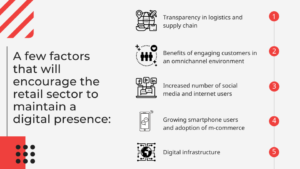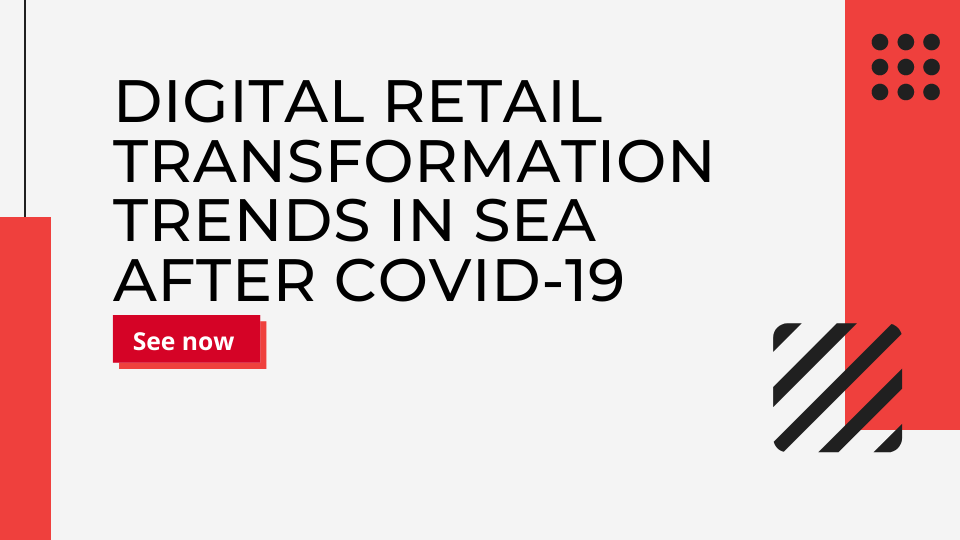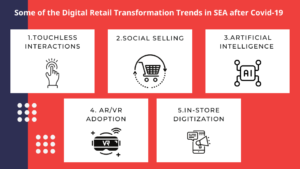Southeast Asian consumers are structuring their spending around online platforms. There is explosive growth in digital spending amid the pandemic, both in terms of spending per person and overall e-commerce sales. Let us understand the key trends SEA is witnessing in digital retail transformation after COVID-19.
1. What does digital transformation mean to the retail industry?
For traditional retailers, digital is disruptive and vice versa. Hence, any transformation in the retail industry was very slow and mostly pushed to meet the growing demands of ever commuting and busy millenials and digitally native Gen Z.
2. The COVID acceleration
Globally, the COVID-19 pandemic has largely catalyzed digital adoption by 2-5 years. A World Economic Forum article says that sales at department stores were down by over 60% for 2020 and e-commerce grew by nearly 20% because of the pandemic. The latter is expected to double in 2021.
COVID has forced retail brands to adopt digital touchpoints to maintain the social norms of physical distancing and avoiding common surface touches.
The retail sector that always prided itself in offering a personal shopping experience to its users faced the hardest choice in the pandemic – to use digital platforms to maintain communication with its customers. But as the world opens up, these trends are here to stay, thanks to the convenience and choice it offers. A few factors that will encourage the retail sector to maintain a digital presence include:

2.1. Transparency in logistics and supply chain
The biggest positive of the COVID-19 pandemic by far is the strength and resilience it has brought to the supply chain and logistics sector. Thanks to the government norm the sector that was already a pioneer in digital adoption accelerated even more by investing in digital tools, IoT devices, and cloud platforms to become lifelines to every country. It has brought efficiency and transparency to the sectors something the retail sector is now used to and will retain these benefits in the new normal.
2.2. Benefits of engaging customers in an omnichannel environment
Adopting e-commerce, m-commerce and other platforms have given the opportunity to engage with their customer over multiple platforms in different ways, also making sure that all these messaging is personalized. Such an insightful digital adoption is going nowhere!
The retail industry hit a jackpot when the Southeast Asian consumer became rich and affluent to start affording smartphones. Also, every growing use and adoption of the internet has only made sure that retail brands stay close to their customers over Facebook, Twitter, Instagram, and other social media channels.
As the internet costs are coming down and usage is increasing, having public Wi-Fi is definitely a must for all retail businesses.
2.4. Growing smartphone users and adoption of m-commerce
Unlike the developed countries, growing economies witnessed the internet revolution in the curve, through 3G wireless connectivity and smartphones. It has become a staple in every consumer’s daily activity to spend an average of almost 170 mins per day on a smartphone.
Just in Southeast Asia, added 70 million digital consumers since the pandemic began, equivalent to the entire population of the United Kingdom and it is estimated that there will be 380 million Southeast Asian digital consumers by 2021. The increased usage of smartphones is expected to drive the growth of mobile commerce in the retail industry.
2.5. Digital infrastructure
Industry 4.0 and IoT adoption have blurred the lines between the digital and physical worlds. Companies can now collect an enormous amount of insights about each customer and understand their preferences to curate personal experiences for them not just through mobile, and web but also through their movement and choices. data sets from physical facilities and assets in real-time, execute advanced analytics to generate new insights and make more effective decisions.
3. Some of the digital retail transformation trends in SEA after Covid-19
3.1. Touchless interactions
In the coming years, contactless shopping experiences have been booming. Although they were introduced lately to reduce the risk of COVID-19 infections, they’re here to stay, because they reduce the time of the shopping, offer quick solutions to the busy millennials. Kiosks are a very good replacement for customizing in-store experiences and promoting daily offers
We have witnessed the growth of curbside pick-up or out-of-store pick-up in restaurants, and now is slowly gaining traction in other businesses such as IKEA furniture store, departmental stores, supermarkets, pharmacies, bookstores, and more importantly fashion, sports goods, and lifestyle stores.
3.2. Social selling
The digital space has made it extremely lucrative for celebrities and other brands to launch their own brands. Established brands are increasingly facing competition from digital-first brands that have more margins, less overall operational costs, and greater visibility on customers’ phones.
WThese brands not only use e-commerce but also social media sites, brand influences, and customer reviews to reach out to their target audience. They incentivize customers to promote brands to their friends, family, and social circle. When the pandemic hit, more brands took the e-commerce omnichannel route to serve their customers. Now in 2022, they also will increase their social presence and adopt social selling strategies.
3.3. Artificial Intelligence
AI that has already revolutionized customer targeting and personalization will also witness further adoption, Use of AI retail operations will smoothen the ordering, finances and also secure the businesses making them more resilient and intelligent.
3.4. AR/VR Adoption
Augmented Reality technologies and tools will not only make shopping fun but also give customers an in-store experience even when they are shopping from home. Many automobile brands, furniture brands have already adopted AR to serve their customers during the pandemic. Now increasing lifestyle and fashion brands will promote these solutions to make customers feel at the store. Especially high indulgence segments such as jewelry and designer boutiques will see the next wave to AR adoption.
Virtual Reality (VR) technology will blur the boundaries of real and virtual taking the customer experience to the next level. IT has potential such as allowing customers to check homes, cars, and other operationally difficult buys without even stepping inside them. Real estate companies use holographic and VR headsets to give customers a walkthrough of the home giving them the actual feel of visiting the property.
3.5. In-Store digitization
In-store digitization is the experience of seeing the results of omnichannel learning in the real world. Imagine a store that recognizes your mobile app login when you enter the property and greets you with recommendations that meet your recent expectations. A fully digital fashion store will completely serve and assist you to find your right look for the upcoming engagement or occasion. Such intuitive insights will make the shopping experience memorable and the brand closer to the customer.
4. Conclusion
Post-COVID pandemic retail sites will not be the same, they will offer more digital interfaces and personalized experiences for consumers. The same holds true for stores, having a simple store won’t help you anymore. You must adopt digital transformation from your physical store into a digital experience and double it up as a fulfillment center to your online store. Social media will also play a key role in decking the fate of your business.
Now that we all have agreed to this, do not lose a minute trying to research and find the best digital transformation partner. Save time, effort, and money by choosing an experienced and fully capable team at Kyanon Digital. Kyanon Digital is a Vietnam-based digital transformation company that specializes in bringing your stores online, building your digital brand, and remodeling your retail business to suit the modern-day requirements of the new normal and make it appealing to the more digitally savvy customers.
All we need to know is the type of retail business you are in and your budget, that’s all. We will come up with a digital transformation strategy that will make you future-proof and profitable at the same time. Contact us today



